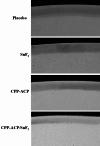Efficient enamel subsurface lesion remineralisation and dentine tubule occlusion by high concentration CPP-ACP: a randomised, cross-over in situ study
- PMID: 40753323
- PMCID: PMC12318122
- DOI: 10.1038/s41598-025-14005-z
Efficient enamel subsurface lesion remineralisation and dentine tubule occlusion by high concentration CPP-ACP: a randomised, cross-over in situ study
Abstract
This study assessed the efficacy of 60% CPP-ACP to remineralise white spot lesions (WSLs) in enamel and to occlude patent dentinal tubules in a double-blind, randomized, cross-over, in situ study. Human enamel specimens with subsurface lesions (WSLs) and root dentine specimens with open dentinal tubules were prepared and inserted into intra-oral appliances worn by volunteers. Participants wore the appliances 24 h a day for four 14-consecutive day treatment periods with a 7-day washout period between treatments. Four treatments applied with a micro-brush once daily were 60% CPP-ACP with and without 1100ppm F as SnF2, 1100ppm F as SnF2 alone and a placebo as negative control. Mineral content was measured using transverse microradiography and dentine tubules were examined using scanning electron microscopy (SEM). The data were analysed using a repeated measures ANOVA with a Sidak adjustment for multiple comparisons. Once daily application of 60% CPP-ACP with or without SnF2 produced 36.6 ± 1.6% and 28.8 ± 1.5% remineralisation of the WSLs respectively, and both were significantly higher (p < 0.0001) than that for treatment by SnF2 alone (8.8 ± 0.7%) or placebo control (2.3 ± 0.4%). SEM analysis of the dentine samples showed that daily application of 60% CPP-ACP with or without SnF2 produced near complete dentinal tubule occlusion.
Keywords: Casein phosphopeptide-amorphous calcium phosphate; Enamel; Fluoride; Remineralisation; Stannous.
© 2025. The Author(s).
Conflict of interest statement
Declarations. Competing interests: The authors declare no competing interests.
Figures






Similar articles
-
Long term remineralizing effect of casein phosphopeptide amorphous calcium phosphate in white spot lesions: A systematic review and meta-analysis.Technol Health Care. 2024;32(3):1239-1254. doi: 10.3233/THC-230722. Technol Health Care. 2024. PMID: 37599550
-
Remineralization of artificial caries lesions using casein phosphopeptide-amorphous calcium phosphate containing probiotic lozenge: an in vitro study.BMC Oral Health. 2025 Jul 3;25(1):1086. doi: 10.1186/s12903-025-06352-0. BMC Oral Health. 2025. PMID: 40611049 Free PMC article.
-
Remineralisation of enamel and dentine with stabilised stannous fluoride dentifrices in a randomised cross-over in situ trial.J Dent. 2024 Apr;143:104895. doi: 10.1016/j.jdent.2024.104895. Epub 2024 Feb 20. J Dent. 2024. PMID: 38387598 Clinical Trial.
-
Efficacy of different remineralization agents on microhardness and chemical composition of enamel white spot lesion.F1000Res. 2024 Sep 3;13:505. doi: 10.12688/f1000research.149166.2. eCollection 2024. F1000Res. 2024. PMID: 39165350 Free PMC article.
-
Caries preventive effect of casein phosphopeptide-amorphous calcium phosphate (CPP-ACP): a meta-analysis.Acta Odontol Scand. 2009;67(6):321-32. doi: 10.1080/00016350903160563. Acta Odontol Scand. 2009. PMID: 19701818
References
-
- Selwitz, R. H., Ismail, A. I. & Pitts, N. B. Dental caries. Lancet369, 51–59. 10.1016/S0140-6736(07)60031-2 (2007). - PubMed
-
- Uribe, S. E., Innes, N. & Maldupa, I. The global prevalence of early childhood caries: A systematic review with meta-analysis using the WHO diagnostic criteria. Int. J. Paediatr. Dent.31, 817–830. 10.1111/ipd.12783 (2021). - PubMed
-
- Bailey, D. L. et al. Regression of post-orthodontic lesions by a remineralizing cream. J. Dent. Res.88, 1148–1153. 10.1177/0022034509347168 (2009). - PubMed
-
- Fejerskov, O., Kidd, E. & Nyvad, B. Dental Caries: the Disease and its Clinical Management (Wiley, 2015).
Publication types
MeSH terms
Substances
Grants and funding
LinkOut - more resources
Full Text Sources
Medical

